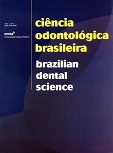Bond strength of dual – cured resin cements to a glass infiltrated alumina ceramic
DOI:
https://doi.org/10.14295/bds.2006.v9i2.479Abstract
The present study evaluated the union resistance among the surface of the ceramic In Ceram Alumina® (Vita Zahnfabrik, Bad-Säckingen, Germany) and two different types of resin cements (Panavia F, Kuraray® e Relyx, 3M®). Six ceramics blocks were made with dimensions of 6x6x5mm following the technical guide lines wich were duplicated in composite resin (W3D MASTER®). One of the faces of the ceramic block (6mmx5mm) was sandblasted with the Rocatec system® and cemented with the two different cements under constant load of 750g to the correspondents faces composite blocks. After the storage of the samples (seven days in distilled water at 37º) each group formed by ceramic, cement and resin was split up in two axis X and Y and it were obtained specimens with adehive area of 1mm² ± 0,1. Two groups (n=27) were obtained: PanaviaF group and RelyX group. Each sample was fixed with cyanocrylate in an adapted device which was attached to a universal testing machine (EMIC) and then subjected to tensile forces at a crosshead of 0.5 mm/min and load cell of 10kgf. The results showed that the medium values of rupture (MPa) for the PanaviaF group (median=30.98 ± standart deviation=5.43) are statistically different comparing to RelyX group (median 12.48 ± standart deviation 3.54) (p-value=0.,001). The conclusion of this study was that the Panavia F had better adhesive resistance than RelyX. All fractures analyzed occurred at the adhesive zone, with no findings of cohesive fracture of the porcelain.
Downloads
Downloads
Published
How to Cite
Issue
Section
License
Brazilian Dental Science uses the Creative Commons (CC-BY 4.0) license, thus preserving the integrity of articles in an open access environment. The journal allows the author to retain publishing rights without restrictions.
=================




























